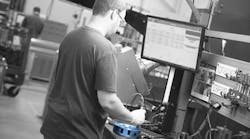Today’s manufacturing facility is filled with all types of equipment – from costly heavy duty machinery to low-budget mobile and handheld devices. Multi-million dollar investments can make, or break, a company’s ability to compete and grow. But on today’s connected plant floor, smaller, lower-cost tools often deliver more of a punch than their higher priced counterparts.
Sensors and smart tools are helping manufacturers produce higher-quality products. The cost of these new technologies have fallen to the point that putting experimentation and trials on the plant floor is well within reach for most operations. Here’s a look at just three ways low-cost technology is impacting the competitive manufacturing industry.
Real-Time Traceability
Traditionally, manufacturers have used whiteboards and tracking sheets to manage their inventory. However, more modern manufacturers now use sensors in the form of low-power Bluetooth, smart tags, and even RFID tags to perform similar tasks. These sensors maintain visibility of any item that remains in constant motion during the manufacturing process.
Here’s how: Consider the journey of raw materials. Material is transported via truck, ship, etc. to a manufacturing plant where it is transformed into a final product. Along the way sensors, tags and smart labels, coupled with ubiquitous wireless and cellular networks, allow manufacturers to monitor and trace both the materials and their path to final production. Not only can these sensors track an item’s location, they can report data about the temperature and turbulence materials endure en route.
Data Collection
As material moves through the manufacturing process, connected sensors capture and report data back so manufacturers can make any necessary changes along the way. Even once a product is made, many manufacturers integrate sensors into their final products. This allows them to collect data on product maintenance and take steps to offer a better customer experience.
This data is collected and stored in a cloud ERP system, which manufacturers can access through an IP address at any time. Unlike legacy ERP systems, the cloud makes adding the connectivity required to grab data from new sensors and tags simple as there is no new development or hardware stack required.
Quality Control
Smart tools that connect to a cloud ERP system are a key aspect of the ongoing cycle of innovation and cost reduction because they make highly complex production lines possible. Take the IP-enabled torque wrenches in the assembly of a complex part, for example. When connected to the cloud, the IP torque wrench captures the torque applied to a specific part, the specific wrench that was used, when that wrench was last calibrated and the employee who used it. Faults can be detected in real time, and even when they’re missed the cloud can trace every part affected back to the root cause.
Connectivity inherent in new cloud ERP solutions makes adding smart tools to a connected manufacturing environment simple. Instead of traditional development processes involving extensive custom code and bespoke systems, tools like IP wrenches and quality testing gear can be added to plant floor operations in minutes. Looking ahead, it may not be the most expensive tool in the plant that has the biggest impact.



